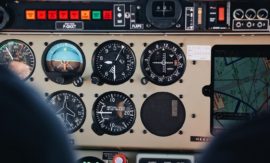Intended learning outcomes: Describe the loading of production resources in the form of a planning board before and after a new entry to orders on hand. Identify the (electronic) control board (Leitstand).
Continuation from previous subsection (15.2.2)
For representing the results of operations scheduling and finite forward scheduling, a Gantt chart is appropriate. A suitable planning board permits the individual loads to be moved around among the workstations in a flexible way.
Figures 15.2.2.1 and 15.2.2.3 show an example of finite forward scheduling with six work centers (WC). The second work center has three workstations (WS), the fourth two. A calendar showing available days for these work centers is shown across the top; the work centers are available only five days per week. Bold areas on the bars mark the related operations of a specific production order. In two cases, an interoperation time has to be respected.
Fig. 15.2.2.1 Loading of production resources in the form of a planning board.
In the scenario in Figure 15.2.2.2, there is an additional order to load. The due date is “as soon as possible.” Existing scheduled jobs are not to be changed. The result of finite forward scheduling of this order is shown in Figure 15.2.2.3. Please note:
- The job is scheduled to start on August 11.
- Both operations are scheduled to run on two workstations.
- Operation 320 is scheduled to begin on August 25.
- The scheduled completion date for order 4711 is Sept. 1 (or close of business day August 30).
Fig. 15.2.2.2 New entry to orders on hand: order 4711.
Fig. 15.2.2.3 Loading of production resources in the form of a planning board, situation following loading of the new order 4711.
For finite forward scheduling, an electronic control board offering graphic capabilities may come into use.
An (electronic) control board (Leitstand) essentially simulates a planning board. At the same time, good electronic control instruments provide an overview of the previous and subsequent operations and thus give information about the consequences of shifting the operations in various ways.
However, such software algorithms do not always lead directly to the objective, so that finite forward scheduling may involve some manual work or reworking. Thus, finite forward scheduling using a planning board is suitable only for production with operations of longer duration.
In summary, finite forward scheduling yields individually released operations together with their sequencing. It may cause aids to be made available and, in the case of disturbances in the process, provide suggestions for potential replanning, such as an altered assignment of personnel or orders to the individual workstation.
Course section 15.2: Subsections and their intended learning outcomes

15.2 Shop Floor Control — Production Activity Control (PAC) — Manufacturing Execution System (MES)
Intended learning outcomes: Describe the issuance of accompanying documents for production. Explain operations scheduling, dispatching, and finite forward scheduling. Present sequencing methods.

15.2.1 Issuance of Accompanying Documents for Production
Intended learning outcomes: For a production order, identify the shop packet. Describe shop order routing, operation card, parts requisitions and picking list.

15.2.2 Operations Scheduling, Dispatching, and Finite Forward Scheduling
Intended learning outcomes: Produce an overview on Operations scheduling and dispatching. Explain finite forward scheduling.

15.2.2b The Planning Board and the (Electronic) Control Board (Leitstand)
Intended learning outcomes: Describe the loading of production resources in the form of a planning board before and after a new entry to orders on hand. Identify the (electronic) control board (Leitstand).

15.2.3 Sequencing Methods
Intended learning outcomes: Explain sequencing and its objectives.
